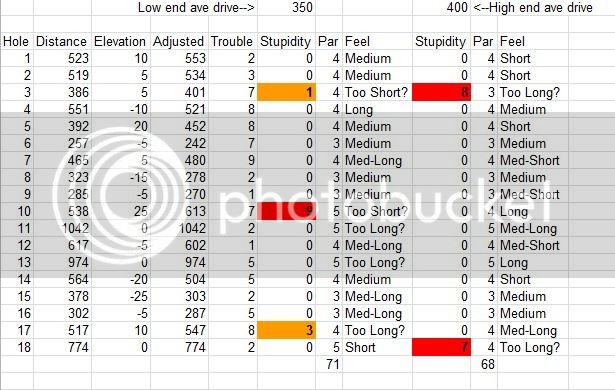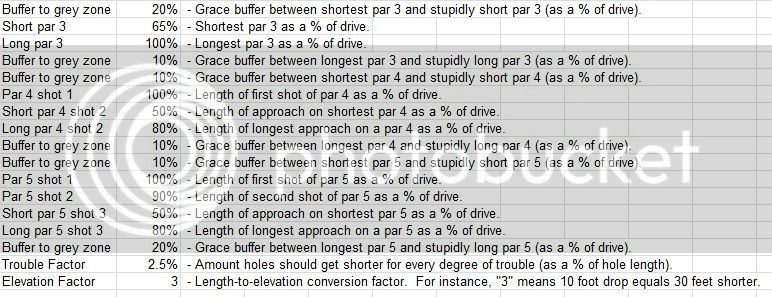Cartograph
Newbie
Does the PDGA ever tell city's what pars their course holes need to be? or is it all made by the cities themselves?
Discover new ways to elevate your game with the updated DGCourseReview app!
It's entirely free and enhanced with features shaped by user feedback to ensure your best experience on the course. (App Store or Google Play)
Does the PDGA ever tell city's what pars their course holes need to be? or is it all made by the cities themselves?
Does the PDGA ever tell city's what pars their course holes need to be? or is it all made by the cities themselves?
Does the PDGA ever tell city's what pars their course holes need to be? or is it all made by the cities themselves?
The PDGA has guidelines but no real requirements.
http://www.pdga.com/documents/par-guidelines
View attachment 54284
"Par" is a hotly debated subject, one that has launched a hundred threads


And has caused par nerds to spend countless hours on the topic.
Back in 2003 I created this SWEET spreadsheet for analyzing the holes on a course, and assigning each a par, and telling you how stupid the hole was for your target audience.
You could input two different average drives (350-400 shown), thus comparing two separate groups (Ams vs Pros), or just comparing the low and high end of a single group.
For each hole, input the:
--Length
--Elevation Change
--Trouble (OB and trees, on a scale of 1 to 9)
Then it tells you the Par (for the given drive length), and how stupid it is. As well as a "feel", like the difference between a short par 4 and a long par 4. A really stupid hole would tend to have all the scores the same for a given group of players.
Example: Hole 18 below is 774 feet with no elevation change. For 350' throwers, it plays as a short par 5. But for 400' throwers, it's a really long par 4, in fact, with a stupid level of "7", you can expect that most players would take a 4 on it, thus providing no separation of skill on this hole.

And the whole thing was driven by a configuration table. So if you didn't like my definitions of Par 3,4,5, you could set your own parameters.

T t t t t t t t t t t too much time on my hands.
How do I get my hands on this puppy?
It has nothing to do with being macho, it has to do with accepting the fact that "par" in any type of golf is supposed to be a standard of excellence, and is supposed to be set at what an expert player, and not a beginner would shoot (and before anyone opens that can of worms again, yeah, I know, we've beaten that horse to death so much there's nothing left to beat).If you want to be a macho-man, then play every hole as a par 3.
If you want to wise up and listen to the course designer's wisdom, then play the course pars as the signs say. A well designed course par will be set up so that par is what a 'beginner' would shoot on average on that hole. 95% of players are beginners, so it makes sense to tailor the course par to them.
It has nothing to do with being macho, it has to do with accepting the fact that "par" in any type of golf is supposed to be a standard of excellence, and is supposed to be set at what an expert player, and not a beginner would shoot (and before anyone opens that can of worms again, yeah, I know, we've beaten that horse to death so much there's nothing left to beat).
The PDGA, the governing body of disc golf, has a stake in establishing an objective standard for this. Your so called revered "course designer" which could be some joe blow who talked his local parks department into putting up a course may not. In some theoretical multiverse scenario, two of these guys could build the exact same course. The only difference being is one of them consulted the PDGA chart to establish objective hole pars, and the other decided to just use what he thought would make beginning players feel good.
Then someone plays both courses and get the exact same score on every hole. Is the round on the second course a better one because its a (-9) 56 and not a (+2) 56?
Its simply ugly fact that on probably 99% of holes under 500 feet, expert players (as well as a great degree of players under that skill level) have no problem consistently carding 3 or less on such holes. Giving them higher pars just so a few beginners (who don't have a full perspective of the game and sport yet, and shouldn't be concerned with par) can feel good right off the bat, is just dumb. And when said beginner started getting their skills honed a little better, he's going to start realizing those 350' "birdie" sign par 3's which he's carding 75% of the time, aren't all that.
the reason i ask is because theres a lcoal course here that ive changed the hole info to what the scorecard says and some guy repeatedly changes everything to what he "Thinks" is what it should be. using the excuse as this is what the pdga officials are changing it to. eventually i said **** it and made a second tee for the real pars because me and my friends like to play with the course designed pars.
Let's use a 501' hole as an example:
For a beginner with an average drive of 200' that hole is a par 5.
For a more experienced player with an average drive of 350' that hole is a par 4.